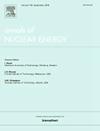MURR LEU structural and thermal hydraulics analyses: Part II – Impacts of irradiation thermo-mechanical behavior on thermal hydraulics safety analyses
IF 1.9
3区 工程技术
Q1 NUCLEAR SCIENCE & TECHNOLOGY
引用次数: 0
Abstract
A series of structural analyses have been performed to support the conversion of the University of Missouri Research Reactor (MURR) from the use of highly enriched uranium (HEU; ≥20 wt% U-235) to low-enriched uranium (LEU; <20 wt% U-235) fuel. The irradiation thermo-mechanical analysis evaluated the effects of fuel swelling, irradiation creep, thermal expansion, as well as thermal resistance from the oxide layer growth for the MURR LEU element in prototypic thermal and irradiation conditions as presented in Part I of this article. Overall, this irradiation thermo-mechanical analysis predicts smaller gap thickness reductions in previously limiting regions, and larger reductions in the middle of the outermost end channels where power density is not typically a maximum. Due to substantial differences between the channel gap reductions assumed for the previous safety analyses and those predicted by the irradiation thermo-mechanical analysis, a need to evaluate their impact on the thermal hydraulics safety analyses arose. This article presents the results from the steady-state safety analysis for normal operation as well as the two most limiting accident scenarios. The calculation models were revised in order to account for the spatial and temporal variation of the channel gap thicknesses. The results show that sufficient safety margins are still maintained for normal operation as well as during the postulated accident transients. This work provides a methodology of incorporating the irradiation thermo-mechanical behavior of plate-type fuel into the thermal hydraulics safety analyses.
求助全文
约1分钟内获得全文
求助全文
来源期刊

Annals of Nuclear Energy
工程技术-核科学技术
CiteScore
4.30
自引率
21.10%
发文量
632
审稿时长
7.3 months
期刊介绍:
Annals of Nuclear Energy provides an international medium for the communication of original research, ideas and developments in all areas of the field of nuclear energy science and technology. Its scope embraces nuclear fuel reserves, fuel cycles and cost, materials, processing, system and component technology (fission only), design and optimization, direct conversion of nuclear energy sources, environmental control, reactor physics, heat transfer and fluid dynamics, structural analysis, fuel management, future developments, nuclear fuel and safety, nuclear aerosol, neutron physics, computer technology (both software and hardware), risk assessment, radioactive waste disposal and reactor thermal hydraulics. Papers submitted to Annals need to demonstrate a clear link to nuclear power generation/nuclear engineering. Papers which deal with pure nuclear physics, pure health physics, imaging, or attenuation and shielding properties of concretes and various geological materials are not within the scope of the journal. Also, papers that deal with policy or economics are not within the scope of the journal.
 求助内容:
求助内容: 应助结果提醒方式:
应助结果提醒方式:


